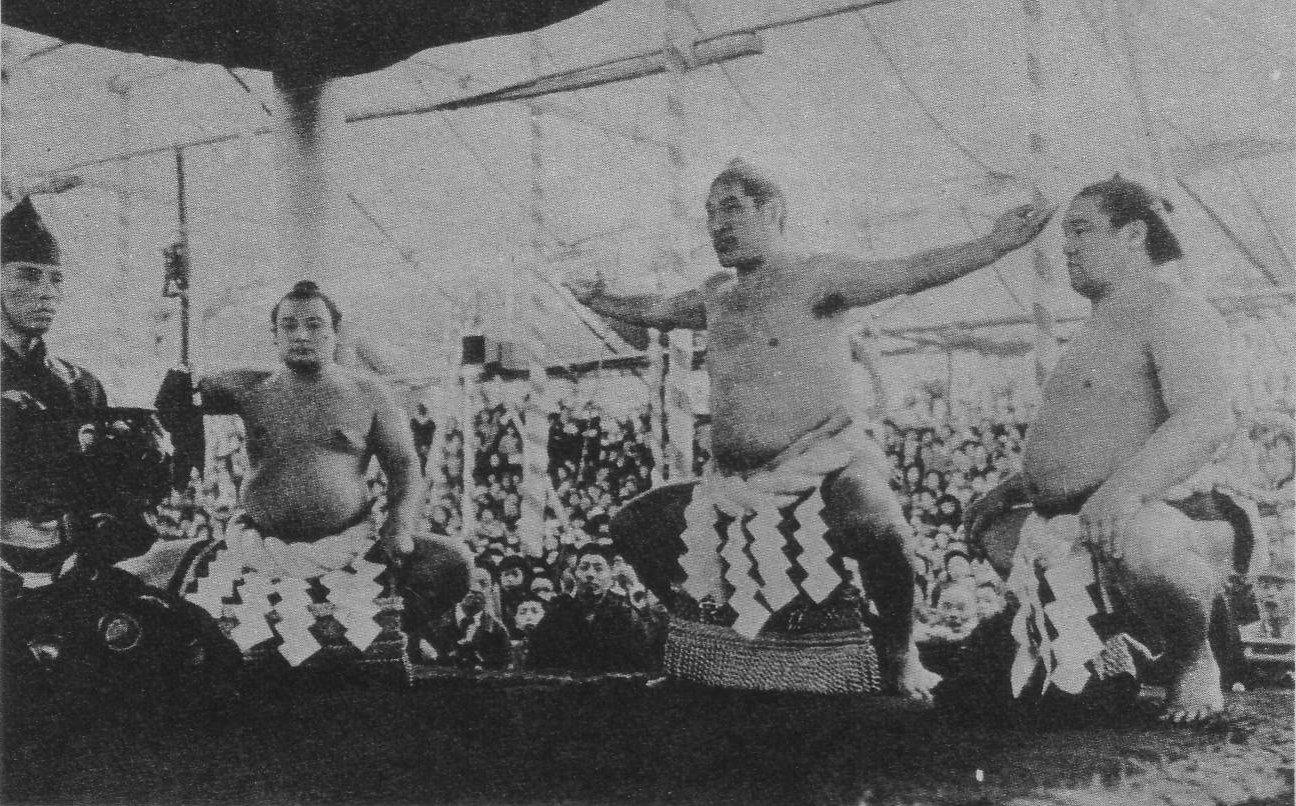Tsuyuharai on:
[Wikipedia]
[Google]
[Amazon]
In professional 
sumo
is a form of competitive full-contact wrestling where a ''rikishi'' (wrestler) attempts to force his opponent out of a circular ring (''dohyō'') or into touching the ground with any body part other than the soles of his feet (usually by thr ...
, the ''tsuyuharai'' (Japanese: 露払い, literally "dew sweeper") is one of the two attendants that accompany a ''yokozuna
, or , is the top division of the six divisions of professional sumo. Its size is fixed at 42 wrestlers (''rikishi''), ordered into five ranks according to their ability as defined by their performance in previous tournaments.
This is the on ...
'' when he performs his ''dohyō-iri
The following words are terms used in sumo wrestling in Japan.
A
B
C
D
E
F
G
H
...
'' or ring entrance ceremony. The other attendant is called the ''tachimochi
In professional sumo, the ''tachimochi'' (太刀持ち; lit.: sword carrier) is one of the two attendants that accompany a ''yokozuna'' when he performs his '' dohyō-iri'', or ring entrance ceremony. The other attendant is called the ''tsuyuhar ...
''.
During the ceremony the ''tsuyuharai'' will precede the ''yokozuna'' into the ring. He will usually be following the ''gyōji
A ''gyōji'' () is a referee in professional sumo wrestling in Japan.
''Gyōji'' usually enter the sumo world as teenagers and remain employees of the Sumo Association until they retire aged 65. There are currently a little over 40 active ''gy� ...
'' who leads the three wrestlers, or ''rikishi'' to the ''dohyō
A ''dohyō'' (, ) is the space in which a sumo wrestling bout occurs. A typical ''dohyō'' is a circle made of partially buried rice- straw bales 4.55 meters in diameter. In official professional tournaments (''honbasho''), it is mounted on a squ ...
''. As the ''yokozuna'' performs the ceremony he will squat on his left hand side. After the ''yokozuna'' has completed his ceremonial dance the ''tsuyuharai'' will once again precede him away from the ''dohyō''.
The ''tsuyuharai'' must be a ''makuuchi
, or , is the top division of the six divisions of professional sumo. Its size is fixed at 42 wrestlers (''rikishi''), ordered into five ranks according to their ability as defined by their performance in previous tournaments.
This is the on ...
'' ranked sumo wrestler (or ''rikishi
A , or, more colloquially, , is a professional sumo wrestler. follow and live by the centuries-old rules of the sumo profession, with most coming from Japan, the only country where sumo is practiced professionally. Participation in official t ...
'') and is, if possible, from the same training stable (or ''heya'') as the ''yokozuna.'' If there are no appropriate choices from within the stable then the ''tsuyuharai'' will normally be from another related stable (from the same stable grouping called an ''ichimon
The following words are terms used in sumo wrestling in Japan.
A
B
C
D
E
F
G
H
...
''). The ''tsuyuharai'' is always the lower ranked wrestler of the two attendants.
All three wrestlers will wear a matching set of ''keshō-mawashi
In sumo, a is the loincloth that (sumo wrestlers) wear during training or in competition. Upper ranked professional wrestlers wear a as part of the ring entry ceremony or .
For top ranked professional , it is made of silk and comes in a var ...
'' belonging to the ''yokozuna'' during the ceremony, and as the ceremony is directly after the ring entry ceremony for the ''makuuchi'' division wrestlers on a tournament day this means that the ''tsuyuharai'' will also wear the ''yokozunas ''keshō-mawashi'' for his own entrance.
A wrestler who is scheduled to fight the ''yokozuna'' on a particular day of a ''honbasho
A is an official professional sumo tournament. The number of ''honbasho'' every year has varied along the years; since 1958 there are six tournaments every year. Only ''honbasho'' results matter in determining promotion and relegation for ''riki ...
'' (or tournament) will not act as his ''tsuyuharai''.
In normal circumstances, the ''tsuyuharai'' will not be another ''yokozuna'' or an '' ōzeki''. An ''ōzeki'' can act as a ''tsuyuharai'' during a wrestlers's very first ''dohyō-iri'', held at Meiji Shrine
, is a Shinto shrine in Shibuya, Tokyo, that is dedicated to the deified spirits of Emperor Meiji and his wife, Empress Shōken. The shrine does not contain the emperor's grave, which is located at Fushimi-momoyama, south of Kyoto.
History
Af ...
in Tokyo
Tokyo (; ja, 東京, , ), officially the Tokyo Metropolis ( ja, 東京都, label=none, ), is the capital and largest city of Japan. Formerly known as Edo, its metropolitan area () is the most populous in the world, with an estimated 37.468 ...
. A ''yokozuna'' will only usually fulfil this role at another ''yokozunas retirement ceremony, or at a special event after the other ''yokozuna'' has announced his retirement, but before the final ceremony.
References
{{Reflist Sumo terminology